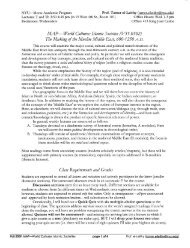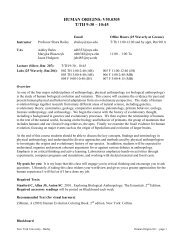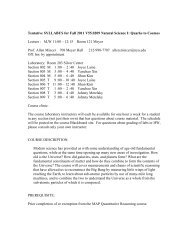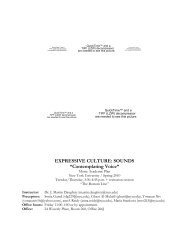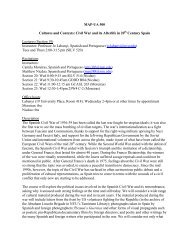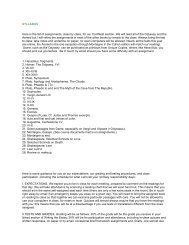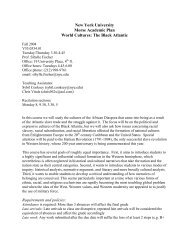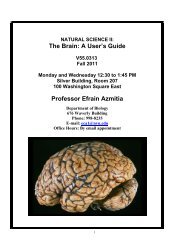You also want an ePaper? Increase the reach of your titles
YUMPU automatically turns print PDFs into web optimized ePapers that Google loves.
CULTURES & CONTEXTS<br />
EGYPT OF THE PHARAOHS: THE NEW KINGDOM<br />
MAP-UA.0545 – Spring 2013<br />
Lecture and Recitation Sections:<br />
MW 9.30am - 10.45am Silver 206 Ann Macy Roth (Section 001)<br />
T 8.00am - 9.15am 25W4 C-19 Mehrnoush Soroush (Section 002)<br />
T 9.30am - 10.45am SILV 501 Mehrnoush Soroush (Section 003)<br />
T 3.30pm - 4.45pm TISC LC13 Elizabeth Feery McGovern (Section 004)<br />
T 4.55pm - 6.10pm KJCC BSMT Elizabeth Feery McGovern (Section 005)<br />
Course Faculty:<br />
Professor: Ann Macy Roth – ann.macy.roth@nyu.edu<br />
Office Hours: Mondays 2:00-3:30 pm, Wednesdays 11:00 am-12:30 pm, and by appointment<br />
Office Location: Silver 303-A8 (in the Grey Art Library); Office Telephone: (212) 998-8991<br />
Section Instructor: Mehrnoush Soroush – soroush@nyu.edu<br />
Office Hours: Wednesdays 8:30-9:30 am and by appointment<br />
Office Location: Silver 303-A8 (in the Grey Art Library); Office Telephone: (212) 998-8991<br />
Section Instructor: Elizabeth McGovern – eaf295@nyu.edu<br />
Office Hours: Mondays 11:00 am-noon, and by appointment<br />
Office Location: Silver 303-A8 (in the Grey Art Library); Office Telephone: (212) 998-8991<br />
Course Description:<br />
This course will introduce the culture of ancient Egypt in the New Kingdom period, 1550-1069<br />
BCE. During this period of imperial conquest, the ancient Egyptian civilization, already more<br />
than sixteen centuries old, increasingly interacted with the peoples and civilizations beyond its<br />
borders. We will examine the remains of this newly cosmopolitan pharaonic culture, including a<br />
variety of primary sources—texts (literature, popular stories, religious writings, letters, and<br />
administrative documents), as well as material culture (works of art, architecture, archaeological<br />
remains). We will learn how scholars analyze this material to reconstruct New Kingdom cultural<br />
life and use these methods themselves to gain insight into the Egyptians' religious beliefs, social<br />
forms and organizations, and conventions and achievements of their literature, art, and<br />
architecture, as well as to critically evaluate the interpretations and reconstructions in the<br />
secondary scholarship. Finally, we will try to see how cultural assumptions interact and<br />
reinforce each other, playing out in a wide range of Egyptian cultural products.<br />
Course Aims:<br />
By the end of the course, students will be familiar with the chronological development of ancient<br />
Egyptian civilization, the basic tenets of its religious beliefs, its social forms and organizations,<br />
the conventions and achievements of its literature, art, and the forms of its architecture.<br />
Moreover, students will understand how scholars have used the remains of the long-vanished<br />
culture to reconstruct it and they will be able to employ these methods to analyze texts and<br />
artifacts themselves.
Course Requirements and Grading:<br />
All grades will be assigned on a 100 point scale and calculated according to the weight of the<br />
grade. The scale is given at the end of the <strong>syllabus</strong> for your reference, along with details on the<br />
course policies. Students are expected to attend all lectures and do all assigned readings, which<br />
will average about 100 pages per week.<br />
Attendance (5%): You will be asked to sign an attendance sheet for each lecture. Initially, your<br />
grade is 100%. Once your unexcused absences have exceed a (low) threshold, your total<br />
absences will be multiplied by 5% and subtracted from this. So, eight unexcused absences gives<br />
you a grade of 60% in this category.<br />
Section Grade (15%): This grade will be assigned by your section instructor, based on section<br />
attendance and participation and completion of section assignments.<br />
Midterm Exam (15%): There will be a midterm exam given in class on Wednesday, April 3rd.<br />
It will include both objective and essay components, and it will cover material from the readings,<br />
lectures, and sections up to that point. Make-up exams can only be taken with a verified medical<br />
or similarly serious excuse approved by Prof. Roth.<br />
Final Exam (30%): A final exam, of the same format as the Midterm but slightly longer, will be<br />
given in our regular classroom on Wednesday, May 15, 2013, 8 am. This is the scheduled<br />
exam time for this class, and it cannot be changed. As with the Midterm Exam, any make-ups<br />
must be approved by the instructor, and they will only be approved for a very pressing, usually<br />
medical, reason. DO NOT make airline reservations to leave town before the exam. This will<br />
not be regarded as a valid reason to take the exam early.<br />
Essays (35%): You will be asked to write four short essays on assigned topics, due February<br />
20th, March 11th, April 15th, and May 13th. The first essay will be 3 pages (~1000 words)<br />
and worth 5% of your grade; the remaining essays will be 5-6 pages (~1800–2000 words) and be<br />
worth 10% of your grade. Spelling, grammar, writing style, organization, and argumentation are<br />
important for these essays. Your section instructors will help you with the analysis necessary.<br />
Required Books:<br />
Course readings will be from the following three books (available at the NYU bookstore and<br />
elsewhere) and PDFs. The readings and assignments are indicated in this <strong>syllabus</strong> using the<br />
boldfaced shorthand.<br />
Lichtheim: Miriam Lichtheim, Ancient Egyptian Literature II: The New Kingdom (Berkeley,<br />
1976). The parenthesis following assignments is for the instructors’ convenience.<br />
Strudwick: Nigel & Helen Strudwick, Thebes in Egypt: A Guide to the Tombs and Temples of<br />
Ancient Luxor (Cornell, 1999)<br />
World: Regine Schulz & Matthias Seidel, editors, Egypt: The World of the Pharaohs (Ullmann,<br />
various dates). In addition to the page numbers, I will give the actual author of the articles in<br />
parentheses.<br />
Readings will be assigned from these books, and from additional texts be posted on the<br />
NYUClasses web sites as PDFs. Section instructors may assign additional readings.
Schedule of Lectures & Reading Assignments<br />
Reading assignments should be done before the class for which they are assigned.<br />
Week 1<br />
Monday, January 28– Course Overview & Egyptian Geography<br />
World 524-525; Strudwick 7-18<br />
Wednesday, January 30 – Egyptian Creation Myths and Cosmology<br />
World (Luft; Görg; Burkard) 417-449, 522-523; PDF: Hornung Non-existence<br />
Week 2<br />
Monday, February 4 – Egyptian Conceptions of Gender<br />
Lichtheim 81-85; 203-210; 181-193 (Hymn to Osiris, Two Brothers; Love Songs);<br />
PDF Roth Gender<br />
Wednesday, February 6 – Egyptian Hieroglyphic Writing<br />
World (Wimmer) 343-355; Lichtheim 167-178 (Be a Scribe!)<br />
Week 3<br />
Monday, February 11 – Egyptian Artistic Conventions<br />
World (Freed) 330-341; PDF Brunner-Traut Aspective<br />
Wednesday, February 13 – Egyptian Kingship & Pre-New Kingdom History<br />
World (Schneider) 323-341, (Kessler) 41-77, 105-107; Strudwick 19-31<br />
Week 4<br />
Monday, February 18 – No Class: Presidents’ Day<br />
Wednesday, February 20 – The Hyksos and the Early Eighteenth Dynasty– Essay #1 Due<br />
World (Kessler) 142-151; Strudwick 31- 38; Lichtheim 12-21 (Abana, Paheri)<br />
Week 5<br />
Monday, February 25 – Hatshepsut and the Tradition of Female Rule<br />
Lichtheim 25-29 (Obelisk); PDF: Hatshepsut Coronation; PDF: Roth Hatshepsut Models<br />
Wednesday, February 27 – Hatshepsut’s Temple at Deir el-Bahari<br />
World (Schulz & Sourouzian) 183-188; Strudwick 72-84; PDF Roth DeB Political<br />
Week 6<br />
Monday, March 4 – Thutmose III & the New Kingdom State<br />
World (Pardey) 356-363, (Gutgesell) 364-376; Lichtheim 21-24, 29-35, 135-146<br />
(Rekhmire, Megiddo, Instructions of Any)<br />
Wednesday, March 6 –Egyptian Temples & Royal Tombs in the 18th Dynasty<br />
World (Schulz & Sourouzian) 153-163, 175-179, 188-191; Strudwick 92-103; Lichtheim<br />
35-48 (Poetical, A II Sphinx; AIII Building)<br />
Week 7<br />
Monday, March 11 – Theban Tomb Painting – Essay #2 Due<br />
World (Kampp-Seyfried) 238-259; Strudwick 139-151<br />
Wednesday, March 13 – Identity and Clothing in the New Kingdom (Elizabeth McGovern)<br />
Spring Break<br />
Monday, March 18 & Wednesday, March 20 (No class) – Enjoy!
Week 8<br />
Monday, March 25 – Agriculture in New Kingdom Egypt (Mehrnoush Soroush)<br />
World (Strauss-Seeber) 376-385<br />
Wednesday, March 27 – The Amarna Revolution I: the Religion & the Politics<br />
World (Schulz & Sourouzian) 199-203; Lichtheim 86-99 (Sun hymns, Aten hymns);<br />
PDF Hornung Akhenaten; PDF Redford Heretic; PDF Reeves False Prophet 52-55;<br />
PDF Aldred Akhenaten 303-306<br />
Week 9<br />
Monday, April 1 – The Amarna Revolution II: the Art & the New Capital<br />
World (Endruweit) 386-397; Lichtheim 48-51 (Boundary)<br />
Wednesday, April 3 – Midterm Exam<br />
Week 10<br />
Monday, April 8 – Tutankhamun’s Restoration of Orthodoxy<br />
World 229-241; Strudwick 103-106; PDF Carter Discovery<br />
Wednesday, April 10 – Early Ramesside Monuments at Abydos and elsewhere<br />
World (Schulz & Sourouzian) 164-174, 179-182, 191-196, 213-215, 204-211;<br />
Strudwick 85-91<br />
Week 11<br />
Monday, April 15 – Ramesses II – Essay #3 Due<br />
World (Kampp-Seyfried) 244-247; Strudwick 105-110; Lichtheim 57-72 (Kadesh)<br />
Wednesday, April 17 – Non-Royal Ramesside Tombs & The Book of the Dead<br />
World (Seidel) 264-269; Strudwick 151-153; Lichtheim 119-132 (BD)<br />
Week 12<br />
Monday, April 22 – The Peoples of the Sea<br />
Lichtheim 224-230 (Wenamon); PDF Murnane United 11-18<br />
Wednesday, April 24 – Ramesses III and Medinet Habu<br />
World (Schulz & Sourouzian) 196-199; PDF Murnane United 19-48<br />
Week 13<br />
Monday, April 29 – Deir el-Medina I: the Town and the Cemetery<br />
World (Kampp-Seyfried) 259-263; Strudwick 168-170, 174-184<br />
Wednesday, May 1 – Deir el-Medina II: Village Life<br />
World (Wenzel) 399-409; Strudwick 184-193; PDF Wente Letters<br />
Week 14<br />
Monday, May 6 – Deir el-Medina III: the Artists & their Art<br />
Lichtheim 181-193 (Love Poems); PDF Romer Painters<br />
Wednesday, May 8 – The Valley of the Kings & the Tombs at Tanis<br />
` World (Siebert) 280-282; Strudwick 111-119<br />
Week 15<br />
Monday, May 13 – The Afterlife of Pharaonic Egypt – Essay #4 Due<br />
World (Schulz) 490-498, (Polz) 499-507<br />
Final Exam: Wednesday, May 15th, 8:00-9:50 am
Policies:<br />
Attendance at lectures and sections is required. If students find it necessary to be absent, they<br />
must present documented excuses. A very small (and undisclosed) number of absences will be<br />
allowed before a grade is affected, but if there is a good (i.e., medical or similarly dire) reason<br />
for your absence, you would be better off documenting it. This documentation should be shown<br />
to your section instructor, if a recitation section was missed, or to the instructor, if a lecture was<br />
missed.<br />
Students are responsible for the material and information presented in lectures and sections,<br />
whether they are present or not. PowerPoints will not, after the first few lectures, be made<br />
available, although individual slides can be posted if students request it.<br />
Students are expected to show consideration for their fellow students in lectures and sections.<br />
All cell phones and pagers should be turned OFF during all your classes. If you are taking notes<br />
on a computer during a PowerPoint presentation, sit at the back of the class so the light from<br />
your screen does not prevent the students behind you from seeing the slides. You should not eat<br />
in class. You should not drinks sugary drinks that might be spilled and attract vermin. You<br />
should not leave trash on the floor or the seats. This should all be obvious.<br />
Essays will not be accepted after the due date without excellent excuses. Extensions will not be<br />
granted unless there are genuinely exceptional circumstances that warrant them. (Poor planning<br />
and last-minute illnesses are not, alas, exceptional.) If you see an exceptional circumstance on<br />
the horizon, e-mailing your section instructor or professor about it before the paper is late (or the<br />
exam is missed) will make the acceptance of your excuse more likely.<br />
Papers may be submitted for comments in advance of the due date. Papers may be submitted to<br />
Prof. Roth or your section instructor at least a week before the paper is due. Note that your paper<br />
will not necessarily be graded by the same person who offered preliminary comments, and<br />
therefore that fixing the flaws pointed out does not necessarily guarantee you an A (or even a B),<br />
although it will almost certainly improve your grade.<br />
The grade of A is given only for papers and exams that exceed the requirements of the<br />
assignment and begin to approach perfection in content and presentation. If you feel a grade is<br />
unfair and would like to re-submit the paper or exam to Prof. Roth, be aware that your grade can<br />
be lowered as well as raised.<br />
Plagiarism and other forms of cheating will not be tolerated. They will be result in a significant<br />
reduction of the grade and they will be reported to the deans, as the faculty handbook requires.<br />
In extreme cases, students will fail the course. Students are strongly advised to avoid even the<br />
appearance of cheating during exams and to be extremely careful about their use of sources.<br />
Changing around the words of a source does not “make it your own.”<br />
Grading Scale:<br />
A 93-100<br />
A- 90-92<br />
B+ 87-89<br />
B 83-86<br />
B- 80-82<br />
C+ 77-79<br />
C 73-76<br />
C 70-72<br />
D+ 67-69<br />
D 60-66<br />
F below 60
Outline of Assignments: MAP Spring 2013<br />
These are very summary descriptions of the short essay assignments that will be required for this<br />
class. You will be given much more guidance in handouts that will describe the required format<br />
and suggest more specific topics and organization.<br />
Essay #1 – (3 pp. 1000 words) – The Basics of Egyptian Culture<br />
Due February 20th<br />
In a very brief essay, discuss the triumphal stela of a 19th dynasty king, Merneptah, in terms of<br />
the Egyptian cultural concepts introduced during the introductory lectures. Use short excerpts<br />
from the text to illustrate some of these concepts. Miriam Lichtheim’s translation of this<br />
monument, the so-called Israel stela, can be found on pp. 73-78 of her book. A large picture of<br />
the stela is posted on the NYU Classes site, and information identifying the figures on the<br />
lunette.<br />
Essay #2 – (5-6 pages 1800-2000 words) – Egyptian-Western Comparison: Texts<br />
Due March 11th<br />
New Kingdom Egyptian texts sometimes fulfilled purposes that are familiar to western readers:<br />
stories entertained, the wisdom of old men advised young men how to succeed in life, hymns<br />
extolled the power and mercy of the divine, lovesick poets tried to express their feelings, and<br />
official texts made the rulers look good. For this assignment, you are asked to choose an<br />
example of these types of literature and to compare it to a corresponding example from the<br />
western tradition, pointing out similarities and differences, and discussing what is distinctly<br />
Egyptian about the Egyptian example. You will be given a list of likely Egyptian texts and<br />
suggestions about where to look for comparative examples.<br />
Essay #3 – (5-6 pages 1800-2000 words) – A Critique of Egyptological Conclusions<br />
Due April 15th<br />
You have been assigned readings from four modern Egyptologists who have written extensively<br />
on Akhenaton and his religious revolution (Aldred, Redford, Hornung, Reeves). You have also<br />
read several documents from his reign: his boundary stela inscription and several hymns to his<br />
new, possibly monotheistic, sun god. Your essay will be a brief critique of one or more of these<br />
authors, using the evidence of the texts and your basic knowledge of the period (from readings<br />
and lectures).<br />
Essay #4 – (5-6 pages 1800-2000 words) – Egyptian-Western Comparison: Art & Artifacts<br />
Due May 13th<br />
Like texts, objects created by the New Kingdom Egyptians are often similar in the purpose or<br />
function to those used in western cultures. As with the texts, a comparison of similar objects can<br />
be used to bring out the distinctive characteristics of Egyptian culture. To do this assignment,<br />
you will choose an object from the Egyptian galleries at the Metropolitan Museum and an object<br />
with the same function in the from a western culture and write a comparison of the two objects,<br />
explaining what their differences tell you about the differences in culture. (Suggestions about<br />
possible pairings will be given.)



